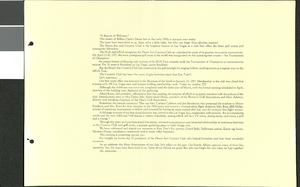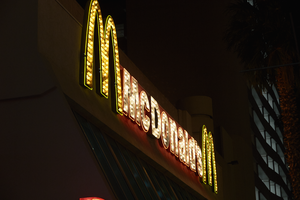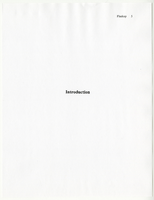Search the Special Collections and Archives Portal
Search Results

Transcript of interview with David Wasserman by Barbara Tabach, October 21, 2016
Date
Archival Collection
Description
For nearly two decades between 1950 and 1970, only one dentist of Jewish ancestry was known to be licensed to practice in Nevada. That was Dr. Joe Chenin. Finally, in 1971, the steadfast and easy mannered Dr. David R. Wasserman (1944 - ) broke through the barrier to become the second Jewish dentist serving the Las Vegas community. Over the following years, Dr. Wasserman built a sizeable following and immersed himself in the Jewish community of Las Vegas. Among his achievements is his participation and leadership in the formation of Las Vegas’ first Reform Jewish synagogue, Congregation Ner Tamid. He also would be active in the Jewish Federation. In 1992, as the HIV-AIDS epidemic affected dental offices throughout the nation, Dr. Wasserman saw an opportunity to get ahead of the infection. With the help of his wife Juanita Davis-Wasserman and his father-in-law Warren Davis, he developed, patented, manufactured and distributed a disposable tip for a treatment instrument commonly found in dental offices called a tri-syringe. This disposable tip brought sanitary options and great financial fortune to Dr. Wasserman and his family. In this oral history, Dr. Wasserman reflects on his joy of living in Las Vegas. He is a highly regarded dentist and leader in the Jewish community.
Text

Brian Greenspun interview, 2018: transcript
Date
Archival Collection
Description
Interviewed by Barbara Tabach. Publisher of Las Vegas Sun, child of Hank and Barbara Green. Part 1 Subjects: Las Vegas Sun, Greenspun family, Israel gun running; Part 2 subjects: Journalism importance, Las Vegas Sun, Watergate tie-in with Hank's safe, October 1 shootings reflections; Part 3 subjects: Hank and Barabara Greenspun. Talks about Jewish visionaries of Las Vegas that includes Art Marshall, Jack Entratter, Sheldon Adelson, Nate Mack; Part 4: Interviewed by Barbara Tabach. Las Vegas Sun newspaper publisher and native Las Vegan talk about events and people from Las Vegas' years of him growing up. From watching pink smoke from test site to hanging out with friends in the John S. Park neighborhood to racial riot of 1969 to playing golf as a kid.
Text
Gregory, Matt, 1921-2000
Las Vegas, Nevada producer, manager, and agent Matthias Gregory Gluchowski (a.k.a. Matt Gregory) was born November 21, 1921 in Araucaria, Parana, Brazil. He was the son of an aristocratic Polish diplomat serving as Ambassador to Brazil. Matthias was raised in southern Poland on a large estate that bordered Czechoslovakia. He was educated at the Marian Fathers Lyceum in Warsaw, Poland, and later came to New York during his father's tenure as diplomat to the United States.
Person

Desert Inn Country Club family album, page 01
Description
Printed text about the Desert Inn Country Club. The paragraph reads: "'A Beacon of Welcome.' This motto of Wilbur Clark's Desert Inn in the early 1950s is apropos even today. The years have been kind to us. Sure, we're a little older, but who can forget those glorious seasons? The Desert Inn and Country Club is the brightest beacon in Las Vegas as a club that offers the finest golf course and community fellowship. The PGA and LPGA recognizes the Desert Inn Country Club as a playland for some of its greatest innovative tournaments. On April 23-26, 1953, the most prestigious golf event in the world was inaugurated on this spanking-new course - the Tournament of Champions. Its unique format of allowing only winners of the PGA Tour compete made the Tournament of Champions an instantaneous success. For 16 years it flourished as Las Vegas' sports headliner. But the Desert Inn Country Club has remained in the golf limelight by staging brilliant, exciting events as regular stop on the LPGA Tour. The Country Club has been the scene of gala festivities since that first T-of-C. Let's reminisce... Our first social affair was featured in the Skyroom of the hotel on January 25, 1957. Membership in the club was closed that evening with 194 Las Vegas men and women holding membership cards. Today we number 275. Although the clubhouse was not to be completed until the latter part of March, with the formal opening scheduled in April, sketches of the building were displayed at the gathering. Allard Roen, club president, officiated at that first meeting, the purpose of which to acquaint members with the policies of the club. Introductions went to Moe Dalitz; Mrs. Helen (Jack) Doyle, president of the Women's Golf Association; and Merv Adelson, director and handicap chairman of the Men's Golf Association. Remember the awards ceremony? That was Mrs. Carmen Colahan and Jim Henderson who presented the trophies to Myron Friedman and Mrs. Roen for their victories in the 1956 men's and women's championship flight divisions. Mrs. Rose (Bill) Holler, winner of numerous tournaments to follow and honored by having an event named after her, was the woman's first-flight winner. A full-page account of our first social function was carried in the Las Vegas Sun, resplendent with pictures. An accompanying article said the new clubhouse "will feature a variety of facilities, among which will be a TV room, dining room, card room, a grill and a lounge." Through the years we have formulated friendships, renewed acquaintances and cemented relationships at numerous festivities in the Country Club and grill room, a popular gathering place to hash things over. We have celebrated and shared our moments at New Year's Eve parties, Grand Balls, Halloween parties, Easter egg hunts, Mexican Fiestas, installation ceremonies and at many other functions. This evening is something special, too. For tonight we honor the 25 presidents of the Desert Inn Country Club who helped formulate and host these wonderful occasions. As we celebrate this Silver Anniversary of our club, let's reflect on the past. Our Family Album captures many of those fine moments. Yes, the years have been kind to us. Some of our friends are gone. But who can forget the nice times we had together? Ah, memories...
Molasky, Irwin
Irwin Molasky (1927-2020) is a Las Vegas, Nevada real estate developer and chairman of the Molasky Group of Companies. He was involved in many major Las Vegas development projects including Paradise Palms, Sunrise Hospital, Nathan Adelson Hospice, the University of Nevada, Las Vegas (UNLV), the Boulevard Mall, Bank of America Plaza, Regency Towers, and Park Towers.
Person

Photographs of The D signs, Las Vegas (Nev.), April 18, 2017
Date
Archival Collection
Description
Site address: 301 Fremont St
Sign owner: Derek Stevens
Sign details: This location first opened as the Sundance in 1980 which was known for its affiliation with Moe Dalitz of the Cleveland syndicate. Then the location was reopened in 1987 as the Fitzgerald's by owner Don Barden, one of the first African American casino owners in Las Vegas. Then in 2012 the renovation process began for Derek Stevens to open up the D casino. The D is named after Derek Steven's hometown of Detroit, Michigan.
Sign condition: 5- Very good condition
Sign form: Variation of a Bull Nose sign, signs on buildings and other entrance signs
Sign-specific description: Above their main entrance on Third and Fremont there is a black backdrop that states "the D" the letters the are in gold lights, then the letter D is in a big red steel box that showcases a tv screen in the big part of the letter, but this letter is outlined in two strips of red neon. Underneath this variation of a bull nose sign is a tv plasma screen that they have wrapped around the building. - On the second story of their casino there is a Vintage Vegas section that can be accessed from the street via escalator, above this second floor entrance is a sign stating "the D Vintage Vegas" At the Top of the building is an animated sculptural sign which is a slot machine with a lever that pulls down with the reels changing such as an old slot machine would have done. Then below this are neon coins that light up in order to look like they are falling out of the slot machine. On the top left portion of the coins states "the (in white) D (in red)", but under the logo is a solid yellow neon line. On top of the yellow line states "Vintage" and on the bottom states "Vegas" in a retro 50's 60's font.
Sign - type of display: Neon, LED, Plasma screen
Sign - media: Steel, some plastic
Sign - non-neon treatments: Light bulbs, T.V. screen and sculptural sign
Sign animation: The coins light up in order to look as though they are falling out of the sculptural slot machine. The lever on the slot machine moves to activate the moving reels in the slot machine.
Sign environment: On the corner of Third and Fremont St. West of the building is the Four Queens, to the North West is the Fremont Casino and Hotel. Across Fremont street from the D is little shops including where the El Portal Movie Theater used to be. Also along Fremont Street the D opened a bar which is very helpful with foot traffic. Also Third Street right in front of their main entrance there is a stage that hold concerts.
Sign manufacturer: AD/S Companies
Sign - date of installation: 2012
Sign - thematic influences: This variation of a Bull Nose sign is similar to many of the other entrance signs for casinos on Fremont Street.
Sign - artistic significance: The Vintage Vegas sign has a retro 1950's/60's type font. The sign really does represent the theme of that section of the casino well by having the old slot machine sculptural sign.
Survey - research locations: Acessor's office website, the D website http://www.thed.com/hotel/ , Neon Museum Tour Manual
Survey - research notes: Derek Stevens also owns the Golden Gate. He bought out the Glitter Gulch, Mermaids and La Bayou in 2015 then the Las Vegas club in 2016. La Bayou was demolished in 2016. The summer of 2017 is when the demolition of Glitter Gulch, Mermaids and the Las Vegas Club began.
Surveyor: Emily Fellmer
Survey - date completed: 2017-08-12
Sign keywords: Neon; LED; Steel; Plastic; Bullnose; Building-front design; Plasma display; Video screen; Sculptural
Mixed Content
UNLV Libraries Collection of Fitzgeralds Hotel and Casino Promotional and Publicity Materials
Identifier
Abstract
UNLV Libraries Collection of Fitzgeralds Hotel and Casino Promotional and Publicity Materials includes newspaper and magazine clippings, a press kit, and promotional materials for Fitzgeralds in Las Vegas, Nevada, and Tunica, Mississippi, dating from 1991 to 2001.
Archival Collection
Toni and Wilbur Clark Photographs
Identifier
Abstract
The Toni and Wilbur Clark Photographs depict Las Vegas, Nevada casino owner and land developer Wilbur Clark and his wife Toni from 1910 to 1975. The photographs primarily document Wilbur and Toni Clark at the Desert Inn, the hotel and casino Wilbur co-owned. The photographs also depict him with politicians and entertainers, and Wilbur and Toni Clark’s house in Las Vegas.
Archival Collection

Jews Wandering in the Desert: A History of the Jewish Community of Las Vegas by Joel Fleekop, May 1, 2000
Date
Archival Collection
Description
Joel Fleekop's senior honors thesis from Brandeis University titled: "Jews Wandering in the Desert: A History of the Jewish Community of Las Vegas."
Text

Transcript of interview with Joan and Leslie Dunn by Barbara Tabach, June 20, 2016 and May 30, 2017
Date
Archival Collection
Description
Among the stories of those who came to Las Vegas in the 1960s to work at the Nevada Test Site is that of Leslie Dunn and his wife Joan. Leslie had been hired by the U.S. Public Health Service to monitor radiation from the explosions. He has tales flying into craters that make you wide-eyed. This assignment would last until his “retirement” in 1983 – one can’t really describe this couple as retired. During these early years, while Les pursued his scientist career, Joan’s chief focus was on raising their three children, Bruce Dunn, Loryn Dunn Arkow, and Sharon Dunn Levin. She also completed her education in accounting at University of Nevada, Las Vegas. She was involved with Equal Right Amendment efforts and League of Women Voters. The couple were only in their forties when Les left the PHS. As he looked forward to new opportunities, he felt compelled to pursue his longtime dream to become a builder, something he had dabbled at as a youngster with his father, Jack Dunn. Together, he an
Text
